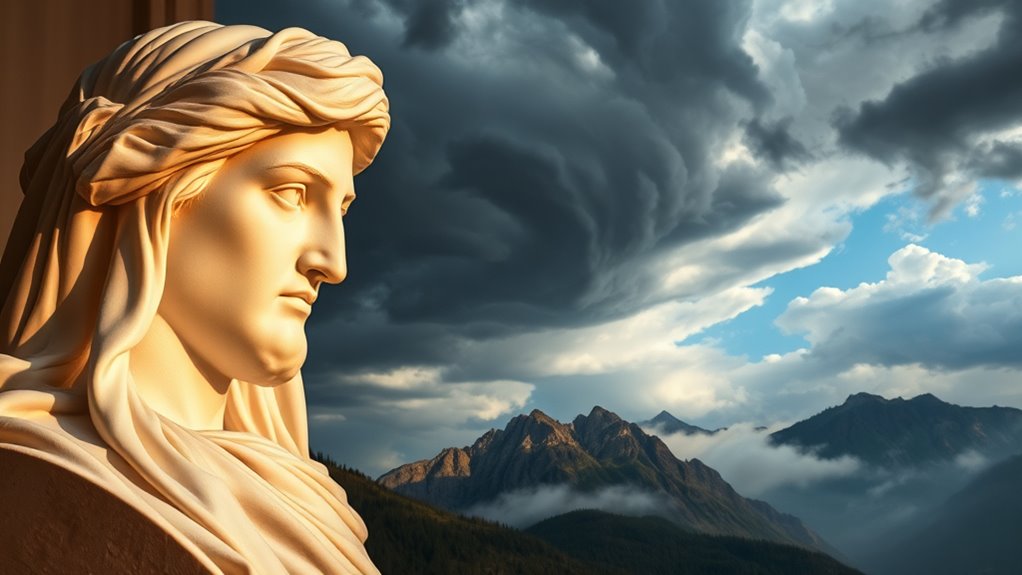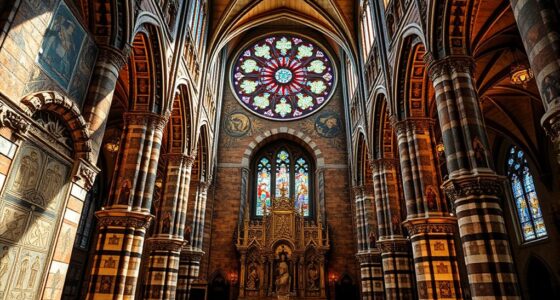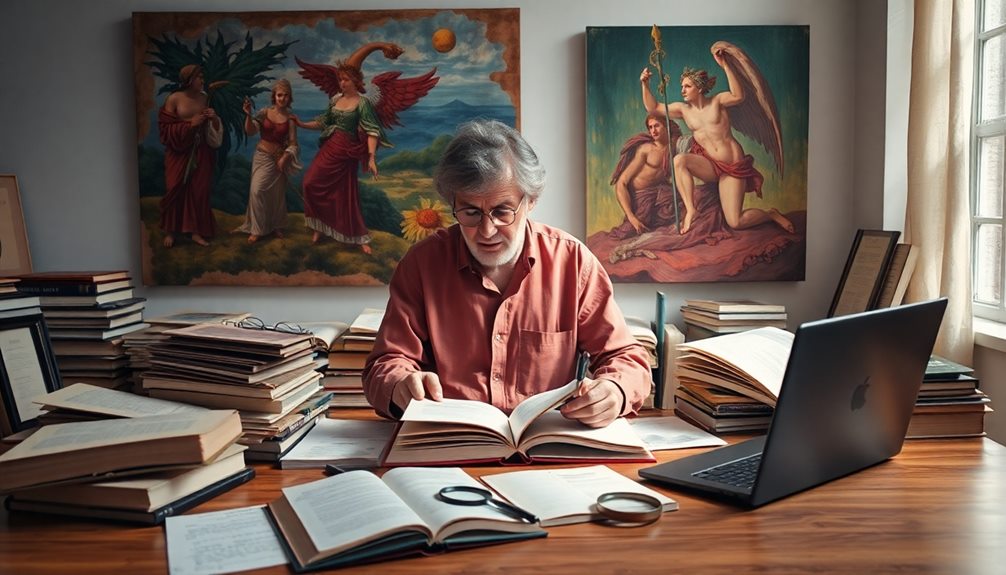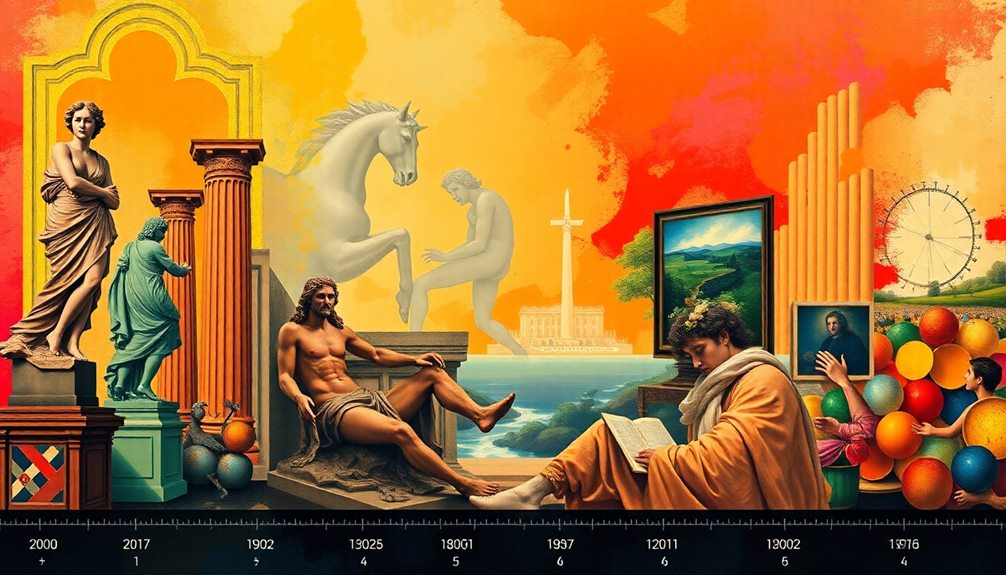During the age of revolution, Neoclassicism and Romanticism emerged as powerful artistic responses reflecting society’s shifts. Neoclassicism emphasizes order, reason, and classical ideals, portraying moral seriousness and civic virtues with clarity. In contrast, Romanticism focuses on raw emotion, individual experience, and dramatic scenes that capture turbulence and heroism. These movements showcase contrasting visions—one grounded in discipline, the other in imagination—and reveal how artists expressed societal hopes, fears, and upheavals in ways that still influence art today.
Key Takeaways
- Neoclassicism emphasizes order, clarity, and moral purpose, drawing from classical Greek and Roman influences during revolutionary upheavals.
- Romanticism focuses on emotional expression, individual experience, and dramatic scenes, often responding to political and societal turmoil.
- Both movements reflect societal shifts: Neoclassicism aligns with reason and discipline, while Romanticism celebrates imagination and personal freedom.
- Art from this era showcases contrasting themes: restrained idealism versus passionate chaos, capturing the revolutionary spirit in different ways.
- Their legacy highlights a transition from rationality to emotion, influencing modern artistic approaches and societal perceptions of art.
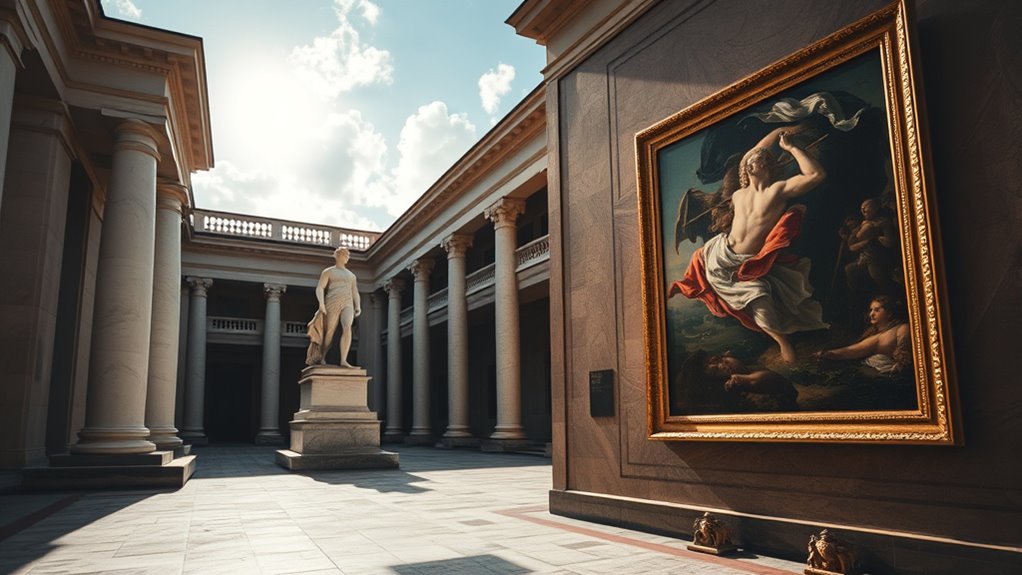
Neoclassicism and Romanticism represent two influential artistic movements that emerged in response to the changing cultural and political landscape of 18th and 19th-century Europe. As you explore these movements, you’ll notice how they reflect different ways artists responded to the upheavals of their time. Neoclassicism draws heavily on classical influence, emphasizing clarity, order, and harmony inspired by ancient Greece and Rome. Its artists sought to revive the ideals of reason and discipline, creating works that exude balance and restraint. You can see this in paintings and sculptures that emphasize clean lines, proportionate figures, and a sense of moral purpose. This movement champions ideals like civic duty and rationality, mirroring the Enlightenment’s focus on knowledge and progress. When viewing neoclassical artworks, consider how high contrast imagery reinforces the movement’s emphasis on clarity and moral seriousness. In contrast, Romanticism shifts your focus toward emotional expression and individual experience. You’ll find that Romantic artists reject the strict rules of classical influence, instead allowing their feelings to guide their work. Their art is passionate, often dramatic, capturing raw emotion and the sublime power of nature. You might be moved by swirling brushstrokes, vivid colors, and intense scenes that evoke awe, fear, or longing. Romanticism celebrates the power of imagination, emphasizing personal expression over classical ideals of order and symmetry. It’s a movement that encourages you to connect with your innermost feelings and to see art as a means of emotional release. While neoclassical works tend to be restrained and idealized, Romantic art often embraces chaos and the unpredictable aspects of human experience. You’ll notice how Romantic artists depict turbulent landscapes, heroic figures, and moments of intense emotion that seem to transcend rational explanation. This movement responds to the political upheavals of the era—revolutions, wars, and a desire for personal freedom—by highlighting individual heroism and emotional depth. It’s as if the Romantics want you to feel the intensity of their vision, pulling you into a world where passion and the sublime reign supreme. Both movements, though contrasting, reveal your society’s evolving relationship with art—a shift from the ordered ideals of the classical world to the passionate pursuit of personal and emotional truth. Neoclassicism anchors you in reason and discipline, while Romanticism invites you to explore the depths of feeling and imagination. You can see how cultural shifts influenced artists’ responses, prompting them to choose different expressive strategies. These shifts are also reflected in the evolving themes explored within each movement, illustrating how societal changes impact artistic expression. This is especially evident in the way Romanticism often draws inspiration from historical upheavals, emphasizing personal and collective struggles. Together, they reflect a society grappling with change, expressing its hopes, fears, and aspirations through contrasting artistic lenses. Whether through the calm, structured beauty of classical influence or the vivid, emotional power of Romantic expression, these movements continue to influence how you perceive and create art today.
Frequently Asked Questions
How Did Political Upheavals Influence Artistic Styles During This Era?
During this era, political upheavals deeply shaped your artistic expression. You see revolutionary symbolism in artworks that reflect the desire for change and freedom, while political propaganda becomes a tool to rally support or criticize regimes. Artists actively incorporate these themes, making their work powerful tools for political messaging. The tumultuous atmosphere fuels creativity, leading to styles that embody revolutionary ideals or oppose oppressive structures.
What Role Did Technological Advances Play in Art Production?
Imagine your creative brush swept by the wind of innovation; that’s how technological advances shaped art. You leverage digital techniques and industrial tools, transforming raw ideas into vivid masterpieces with precision and speed. These innovations act like magic wands, expanding your artistic possibilities, making intricate details easier, and pushing boundaries. Technology becomes your partner in capturing emotion and vision, turning traditional craftsmanship into a dynamic dance with modern ingenuity.
How Did Public Reception Differ Between Neoclassical and Romantic Artworks?
You’ll find that audience expectations greatly influenced how people received artworks. Romantic artworks often evoked strong emotions, resonating with viewers seeking personal meaning, which made them more accessible emotionally. In contrast, neoclassical art emphasized order and rationality, appealing to audiences valuing tradition and clarity. As a result, Romantic art tended to evoke passionate responses, while neoclassical pieces aimed for a more restrained, intellectual appreciation.
Were There Prominent Female Artists Associated With These Movements?
They say “the future is female,” and indeed, women artists played essential roles as female pioneers in art movements. You’ll find notable women artists like Angelica Kauffman and Marie-Louise-Elisabeth Vigee-Lebrun, who broke barriers and gained recognition. Their works contributed to the dynamic evolution of art, proving that, despite challenges, women artists thrived and left an indelible mark on Neoclassicism and Romanticism.
How Did These Styles Influence Contemporary or Later Art Movements?
You see that neoclassical influence and romantic legacy shape contemporary art by emphasizing emotion, individualism, and classical themes. These styles inspire modern artists to explore expressive storytelling and bold visuals. The neoclassical focus on order and clarity continues in current design principles, while the romantic legacy encourages personal expression and emotional depth. This lasting impact helps you appreciate how historical art movements still inform and inspire today’s creative practices.
Conclusion
As you explore neoclassicism and romanticism, remember that art reflects the times and your own passions. These styles show how order and emotion shape human experience, just like the saying “beauty is in the eye of the beholder.” Embrace both reason and passion in your appreciation of art, for understanding history deepens your connection to creativity. After all, it’s through contrast that true insight emerges, guiding you toward a richer perspective.
